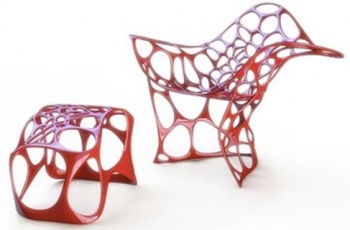
Most furniture isn't produced by 3D printing, but there are great designs out there. Check out some of the coolest 3D printed furniture!
3D PRINTED FURNITURE: STATE OF THE ART
Setting the Bar
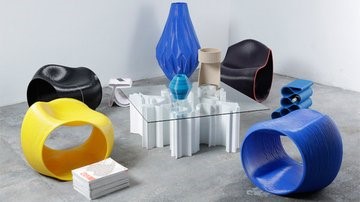
3D printing offers design freedom that's impossible with traditional fabrication methods (Source: Sociable)
3D printing has spread across many different areas, and the furniture industry is no exception. Yes, furniture is still mass-produced using traditional manufacturing methods, but 3D printing has come in handy for designers who want to bring innovation into the market.
Still, 3D printing isn’t the most appropriate tool for furniture. For example, printing plastic stools can’t rival the normal mold-making process just yet. What 3D printing does offer is a great tool for producing high-end furniture, often developed by famous designers who want to explore new shapes and ideas.
Such furniture, as you may know, is produced in rather limited quantities and often features complex geometries, which is easier to produce with 3D printing. This often results in extraordinary designs, which are hard or impossible to produce with molds.
We’ve compiled a list of some of the coolest 3D printed furniture we’ve seen so far. It should be noted that many pieces of the incredible furniture described below, when available for purchase, are quite expensive. On the other hand, some on our list are displayed or used in public, and one has files that you can download for free. Let’s take a look!
3D PRINTED FURNITURE: STATE OF THE ART
Nagami's Chair Collection

The Brave New World collection brought the 3D printed chair to the Milan Design Week in 2018 (Source: Nagami Design)
Nagami is a Spanish design brand that “explores the future of product design in a new technological era”. The brand’s first collection, Brave New World, consisted of four 3D printed chairs designed by different architects and designers. All the chairs were created using FDM 3D printers and were introduced to the world during the Milan Design Week in 2018.
The first two chairs out of the collection, the Bow and the Rise, were designed by Zaha Hadid Architects, who were inspired by sea life. Both chairs were 3D printed using PLA. In the above image, the Rise chair appears on the far right and the Bow to the left of it. The sea life design inspiration is especially visible on the Rise, which is meant to represent a coral reef. The Bow and Rise are limited editions, available by price consultation only.
The Peeler, the black chair on the far left, was printed by London-based designer Daniel Widrig. The chair consists of three parts, creating the effect of its parts peeling off of an invisible joint, hence its name.

Nobu, the newest addition to Nagami's 3D printed chair collection (Source: Nagami Design)
The newest addition to Nagami’s 3D printed furniture is the Nobu. This blue chair clearly represents the lines from FDM printing layers. It was designed by Manuel Jiménez García, co-founder of London-based MadMDesign. According to the artist, Nobu represents a membrane that “hides an internal cellular universe” and “reflects both smoothness and regularity while also arrhythmia and madness.”
- Designers: Patrik Schumacher (Zaha Hadid Architects), Daniel Widrig, and Manuel Jiménez García
- Location: Spain
- Price: €1,560 (~$1,700) for the Peeler; €940 (~$1,020) for the Nobu
- Source: Nagami Design
3D PRINTED FURNITURE: STATE OF THE ART
Ocke Series
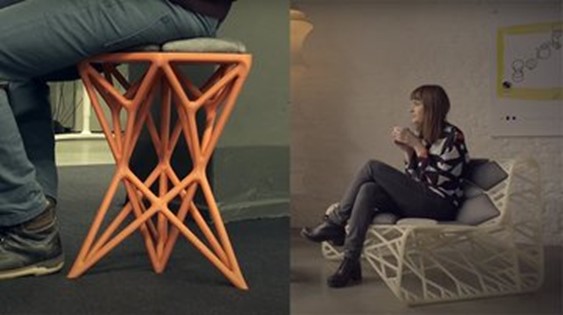
Müller's designs doesn't require any support structures (Source: BigRep via YouTube)
The Ocke Series is a set of 3D printed furniture consisting of a chair and sofa. Both the chair and the sofa were designed by Beatrice Müller, an industrial designer at BigRep. BigRep is a German company specializing in FDM 3D printers with large print volumes and precision.
This furniture series was created as a demonstration of what BigRep’s One 3D printer was capable of making. The One features a build volume of 1 m³.
While designing the Ocke Series, Müller wanted to achieve a design that would be able to speak for itself. In other words, people should recognize that the chair and the sofa were designed specifically for 3D printing.
Another interesting design feature Müller applied is the ability to print the furniture without using any support material. This was achieved by positioning the poles – the main structural elements of the pieces – at low angles.
- Designer: Beatrice Müller
- Location: Germany
- Price: Not for sale
- Source: BigRep
3D PRINTED FURNITURE: STATE OF THE ART
Sofa So Good Lounger
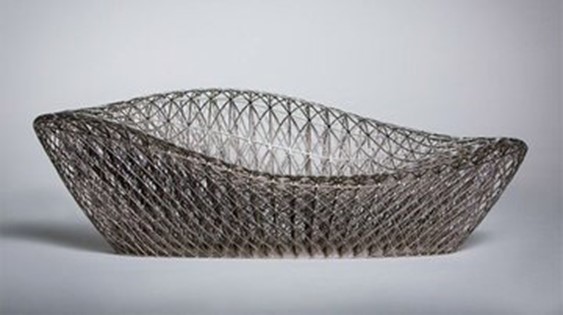
This SLA 3D printed lounger used only 2.5 liters of resin (Source: Janne Kyttanen)
This amazing piece of furniture was created by Janne Kyttanen, who works as a 3D printing expert at 3D Systems. The lounger you see in the picture above features an incredible complex mesh design, resembling a metal-coated spider web.
The lounger is called Sofa So Good and was created using 3D System’s ProX 950, an industrial, large-volume SLA 3D printer. Kyttanen’s design enables the lounger to be printed with as little material as possible while still maintaining structural strength.
The single print design used only 2.5 liters of resin, which translates to 6,000 layers. It measures 1.5 meters (almost 5 feet) in length and weighs only 2.5 kilograms (about 5.5 pounds). According to its designer, it’s able to support a maximum weight of 100 kilograms (about 220 pounds).
- Designer: Janne Kyttanen
- Location: USA
- Price: Not for sale
- Source: Janne Kyttanen
3D PRINTED FURNITURE: STATE OF THE ART
Batoidea Chair & Footstool
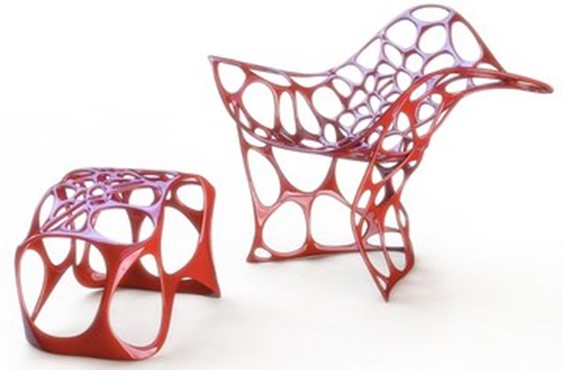
Batoidea furniture resembles the type of stingray that its named after (Source: Peter Donders)
The Batoidea 3D printed chair and stool are remarkably-shaped pieces of furniture designed by Peter Donders. This premium furniture set retails for $26,378 and is part of a limited edition collection.
Both pieces were created from 3D printed sand molds, which according to the artist, is the exact same method used to produce the internal core of the Ferrari engine. It took a total of five sand mold parts, all manufactured by Voxeljet’s service center in Augsburg, Germany.
The thin-walled aluminum cast structures were then painted using the same technique Ferrari uses to paint the bodywork of its supercars, which helps to explain the very high cost.
- Designer: Peter Donders
- Location: Belgium
- Price: $26,378
- Source: Peter Donders
3D PRINTED FURNITURE: STATE OF THE ART
Rio Collection

These side tables combine 3D printed parts with traditional furniture materials (Source: Morgan Furniture)
The Rio collection is a collaboration between furniture maker Morgan Furniture and studio Integrate. It consists of backrest chairs and a side table that combine 3D printed parts with traditional furniture materials, such as wood and glass.
The 3D printed lattice structure was designed entirely by a computer algorithm, which ensured the ability to sustain weight while optimizing the material used. This resulted in a unique and gorgeous design that’s manufactured either with resin (SLA) or polyamide powder (SLS).
The Rio collection was launched at the London Design Festival in 2016 and aimed to explore the relationship between “the craft of today with the craft of tomorrow.” It’s available for purchase at the Morgan Furniture website, though the price is through quote inquiries only.
- Designer: Studio Integrate
- Location: London
- Price: Available on demand
- Source: Morgan Furniture
3D PRINTED FURNITURE: STATE OF THE ART
SuperMod Wall System
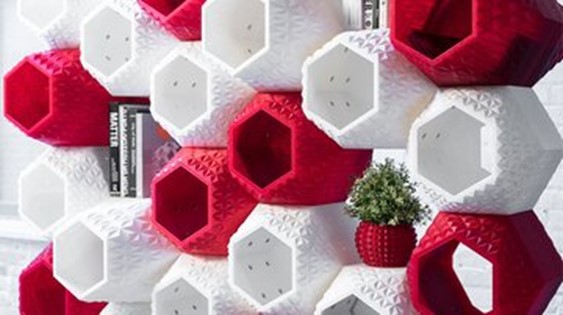
The 3D printed materials allow for light to come through certain modules (Source: Simplus Design)
SuperMod is a modular wall storage system that’s both practical and stunning. The 3D printed hexagon-like modules can be combined in various ways to produce different wall designs, with flexibility in the amount of empty space or niches. The resulting structure can be used to store anything from books, plants, and decorations, but it can also simply serve as an ambient partition.
The system was designed by Sebastian Misiurek and Arianna Lebed of Simplus Design, a studio in New York City. It was first exhibited at the local 3D Print Design Show in 2015.
Their designs rely on digital methodologies and rapid prototyping to create engaging projects and functional objects. The SuperMod was produced on MakerBot machines with each module sizing from 14 to 22 inches.
- Designers: Sebastian Misiurek and Arianna Lebed
- Location: USA
- Price: Not for sale
- Source: Simplus Design
3D PRINTED FURNITURE: STATE OF THE ART
Multithread
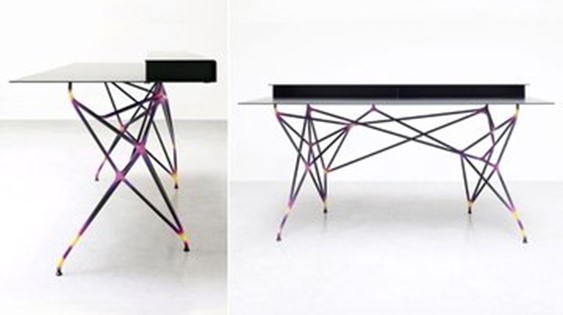
The joints were 3D printed using SLM before being hand painted (Source: Interspace Design)
Multithread, an art project by designers Reed Kram and Clemens Weisshaar, uses 3D printed joints to make tables, shelves, and desks. The Swedish and German duo founded their design studio in 2002, and since then, they’ve been integrating the latest technological advances into their projects.
In Multithread, the lattice structures that support the flat surfaces of various pieces of furniture were optimized by custom software that “analyzes, modifies, and paints” the joints according to the forces to which they’re submitted. The joints were digitally designed and 3D printed using selective laser melting (SLM).
After printing, the parts were hand polished and the final structure was assembled. In the end, each joint was custom painted using the color pattern designated by the design software to illustrate the mechanical stress applied to that specific part. The final pieces were displayed at Milan’s Nilufar Gallery in 2012 and the Istanbul Design Biennial in 2013.
- Designers: Reed Kram and Clemens Weisshaar
- Locations: Italy and Turkey
- Price: Not for sale
- Source: Kram/Weisshaar
3D PRINTED FURNITURE: STATE OF THE ART
Print Your City! Recycled Public Furniture

This bench in Amsterdam was 3D printed out of local recycled plastic (Source: Print Your City!)
Print Your City! is an ongoing research project aimed at recycling household plastic waste and using it to 3D print public city furniture. The project was envisioned by Rotterdam-based design studio The New Raw and was kickstarted in 2016 in Amsterdam as a test run.
The first piece of furniture the Dutch capital received was a custom public bench weighing around 15 kg (about 33 pounds). According to Foteini Setaki, The New Raw’s co-founder, this is equivalent to the total plastic waste produced by two Amsterdamers per year. The large-scale 3D printing was done locally by Aectual, a company also involved with design and sustainability.
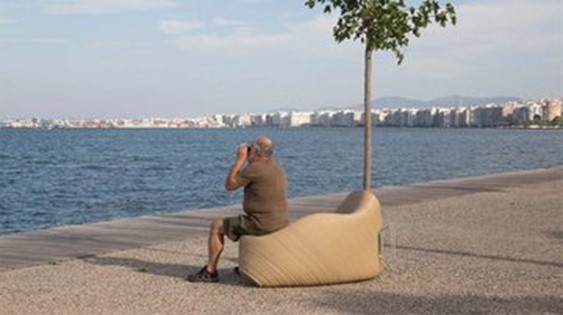
An initial prototype design on Thessaloniki's waterfront promenade (Source: The New Raw)
With the recycling and printing processes a success, the project moved on to yet another city: Thessaloniki. In collaboration with various organizations, including Coca-Cola, a Zero Waste Lab was implemented in the Greek city, with recycling facilities and a robotic 3D printing arm. Locals can take their household waste to the lab and learn more about the recycling processes.
- Designer: The New Raw Studio
- Location: The Netherlands and Greece
- Price: Free
- Source: Print Your City!
3D PRINTED FURNITURE: STATE OF THE ART
One_Shot Stool

The One_Shot stool can be collapsed with an easy twisting motion (Source: Materialise)
One_Shot.mgx is a functional stool from Patrick Jouin for a design project by Materialise. The project was .MGX, and it challenged artists and designers to create an inspiring 3D printable design collection.
The One_Shot stool has a dynamic structure that allows it to be folded, just like an umbrella, for transportation or storage. The collapsing movement is fluid, making use of a twisting motion and gravity. The entire piece, including all moving parts and hinges, are 3D printed together using selective laser sintering (SLS).
This intricate design is available for purchase, along with other furniture and decorative items, in limited quantities at Materialise’s online shop.
- Designer: Patrick Jouin
- Location: France
- Price: €2,165 (~$2,336)
- Source: Materialise
3D PRINTED FURNITURE: STATE OF THE ART
Bits & Parts Chairs
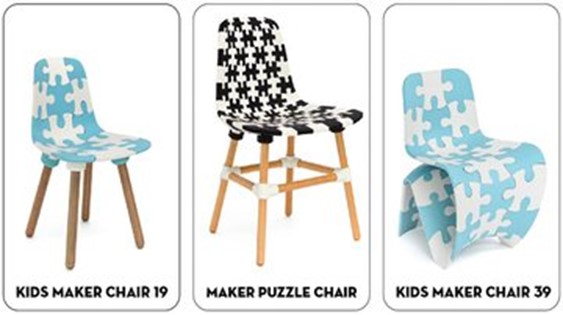
There are currently three 3D printed chair models available for free download (Source: Bits & Parts)
Imagine being able to 3D print an entire chair with your own printer. That’s the idea behind Bits & Parts, a spin-off project from the Makerchair series by designer Joris Laarman. The first prototype was made by a 3D printing hub, and according to their website, it was the world’s “first crowd-fabricated chair.”
There are currently three models available: the Maker Puzzle Chair, the Kids Maker Chair 19, and the Kids Maker Chair 39. All of them can be downloaded for free and be printed by anyone with a 3D printer (and time!). Each unit is assembled like a 3D puzzle to form the final piece of furniture.
The Kids Maker Chair 19 is made from 15 puzzle pieces plus 4 connector rings for the wooden legs. According to its website, 1.5 kg of filament for each color should be enough for this model, while the legs are made from standard broomsticks.
The entire project is a constant work in progress, where makers around the globe can join ranks and enhance the designs.
- Designer: Bits & Parts
- Location: The Netherlands
- Price: Free for download
- Source: Bits & Parts
3D PRINTED FURNITURE: STATE OF THE ART
Final Thoughts
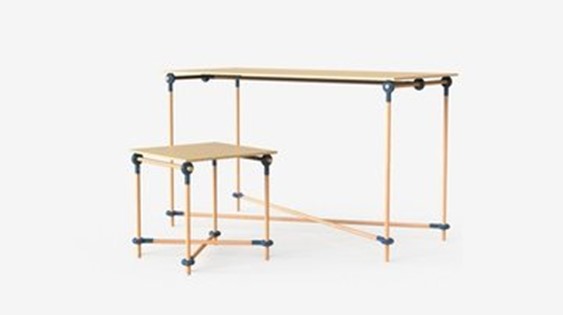
While 3D printed furniture isn't yet very accessible, you can still start with small DIY projects (Source: Cults)
Most of the furniture we’ve seen in this article was made by studios and designers who wanted to explore the production capabilities of 3D printing. As time goes by, we think that 3D printing will eventually make its way into cheaper, mass-produced furniture.
In the meantime, if you want to venture further into the world of 3D printed furniture, you can start by checking Cults’ awesome selection of furniture models that you can print yourself.


